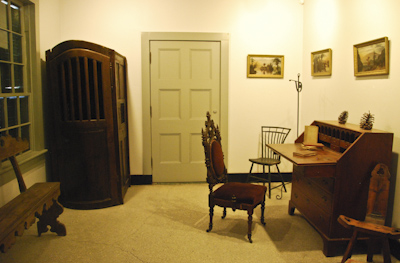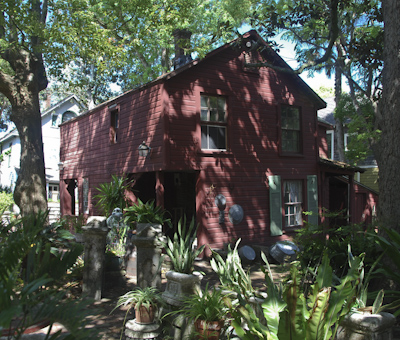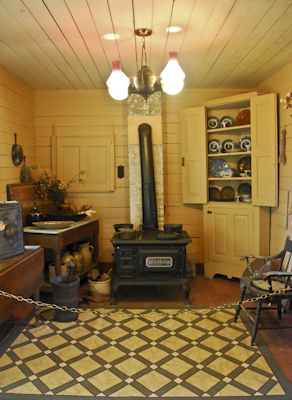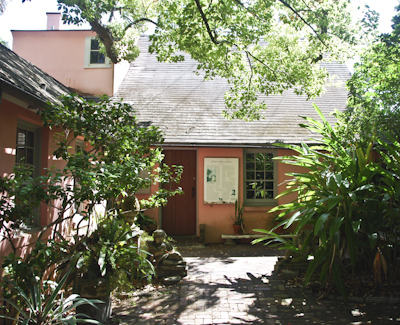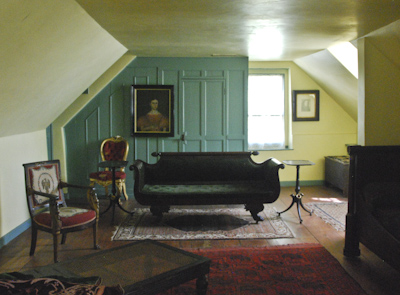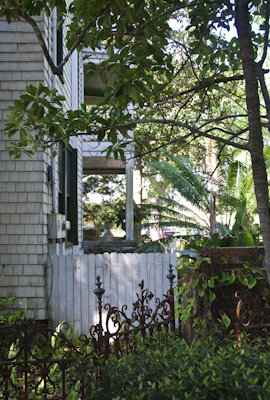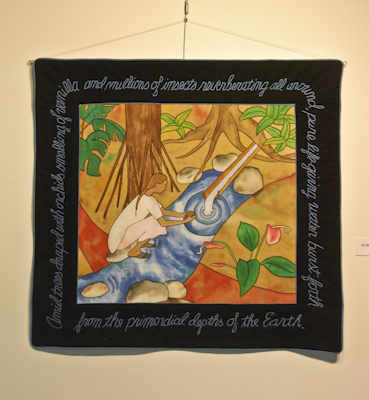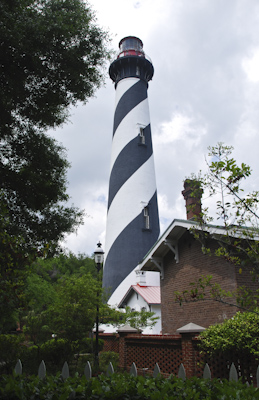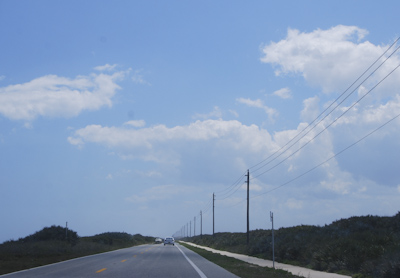Friday, April 8, 2011
Yesterday, we ran out of time to see all the sights we wanted to visit in St. Augustine. Sometime in the future we will have to return to St. Augustine to see everything we missed, but before we left, we wanted to see the Dow Museum of historic houses on Cordova Street. It was once known as The Old St. Augustine Village.
 Visitor’s Reception & Ticket Office
Visitor’s Reception & Ticket Office
We were at the entrance a little after 10:00 o’clock when the Dow Houses opened their gate. The village is made up a nine historic houses dating from 1790 to 1910. The museum is a small neighborhood of houses which were built where they currently stand over the last 220 years. A man named Kenneth Dow, who was a wealthy collector, purchased the houses and contents and turned it into a museum.
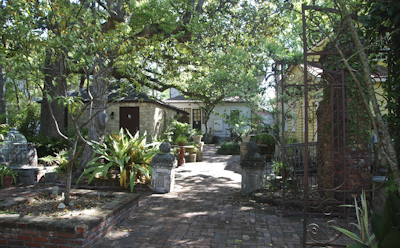 Garden Path Between the Houses
Garden Path Between the Houses
Visitors enter through an old iron gate and into a lovely, if slightly overgrown, garden as if stepping back into time. A sign directs visitors to enter the first house on the right. Inside is a small gift shop and a cheery receptionist. She handed us a map and explained the direction of the path and wished us well on our self-guided exploration through history.
None of the houses were moved. It was a clever idea which took advantage of the well preserved state of the houses and their contents. Each house was furnished in period pieces which date to the aproximate construction period of the house.
We followed the map and the paths from house to house. It was a fun exploration through history, not necessarily chronological, but a fun game of “what was behind the next door”? As we progressed, we began to get the feeling that the houses needed a large dose of capital improvement as well as much TLC.
The museum was a unique opportunity to see the changes in American architecture and culture in a relatively small space. The changes from Colonial to Victorian times were evident in just one rectangular block of homes. Volunteers were gardening and weeding the areas between the houses.
The most elaborate house, dating from 1790, had belonged to the King of Naples, Prince Napoleon Achille Murat, one of Napoleon Bonaparte’s nephews. His wife was George Washington’s grand niece, according to the sign on the building.
The house needed much repair as was evident from peeling paint and plaster on the walls. It’s unfortunate that the Dow Houses did not have a benefactor with a lot of money. A major transfusion of money to preserve the buildings and provide costumed guides in each house would make this a major historic attraction.
Of course, the biggest house was the big white Victorian home built in 1910. The upstairs rooms were used as artists’ studios and the main level was an art gallery. The current exhibit was “quilts” or painted and sewn fabric art by a very talented artist.
When we got back to the original ticket house to return the map, we learned that the Dow Houses are owned by the Museum of Arts & Sciences in Daytona Beach. Mr. Dow had wanted to give his collection of houses to the Lightner Museum, but they rejected his offer and the Museum in Daytona accepted his collections.
Since we were going south, we thought we would stop at Daytona Beach to see the rest of the Dow Collection. We drove east toward the Atlantic Ocean and onto Route A1A. Two of St. Augustine’s attractions are the Lighthouse and the ‘Gator Farm. We stopped off to see the black and white stripped lighthouse but skipped the alligators.
Back along the coastal road, it was a flat and straight road southward. The sun was shining brightly and the temperature was in the 80s. It didn’t take long to arrive at Daytona Beach. This city was like all the other coastal resorts: tall hotels lined the beach with restaurants and tourist shops on the land side.
We found the road to the Museum of Arts & Sciences and, to our surprise, a long twisting driveway through dense tropical gardens opened to a very modern building. Unfortunately, photography was not allowed inside the building so I do not have photos of the wonderful exhibits inside this amazing museum.
After we paid our admission fee, we saw a fabulous exhibit of photographs taken by Frederick W. Glasier. Neither of us had ever heard of him before and we were amazed at the high quality of his photographs. Perhaps Glasier was unknown because his subject matter was the circus and “wild west” performers in the early 1900s. His black and white photographs were incredible and the Ringling Museum of Art currently owns 1,800 of Glasier’s negatives and glass plates. I highly recommend a web search.
The next room was full of the collections of the Root Family. The collection included: Coca-Cola memorabilia, more than 800 Teddy Bears, Indy race cars, an apothecary shop, and two mid-century railroad cars. The Root Family Glass Works was the largest Coca-Cola bottler in the U.S. after they created the design of the Coca-Cola bottle.
In the days of rail travel, wealthy families owned their own railroad cars. The Silver Holly, an Art Deco masterpiece, was converted by the Root family to a private coach with a kitchen, living room, and enough beds for six children. The 1948 Hiawatha is a fully restored Beaver Tail observation car. The railroad cars were housed in a covered pavilion which looked like a railroad station. I could take a few photos because the cars were “outside”.
The Museum of Arts and Sciences also had collections of American, Cuban, African, English, Chinese, European, Pre-Columbian art and also fossils, crystals, gems, and minerals. One large exhibition hall showcased Kenneth Dow’s collection of American decorative arts. This is where they kept all his “good stuff”. See the museum’s website for photos of a small part of their holdings and visit the museum when you are in the Daytona Beach area.
We left the museum completely amazed and happy that we had discovered it. We continued south along Route A1A through the Florida beach communities whose names we recognized from friends and relatives who were “snow birds”. Our goal was Delray Beach where my mother, brother, sister-in-law were staying for the winter. We had traveled more than 1,500 miles along the coast and had arrived in warm, sunny Florida. It was an interesting trip full of discoveries and adventures. Now it was time to take a break. Hooray!!
